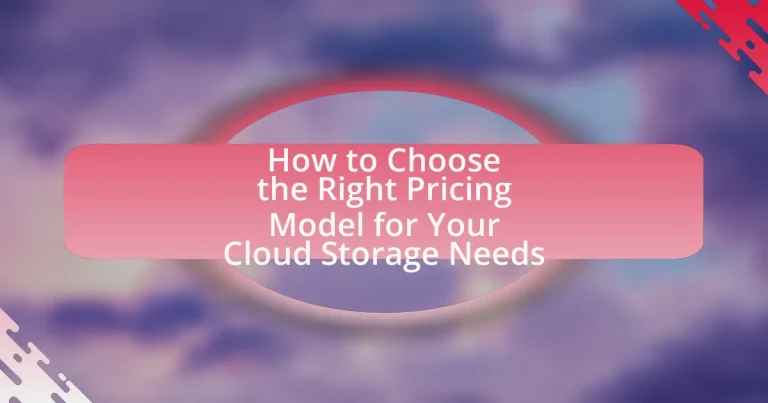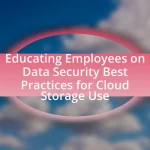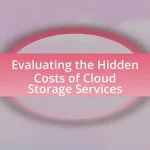The article focuses on selecting the appropriate pricing model for cloud storage needs, detailing various options such as pay-as-you-go, subscription-based, tiered pricing, and reserved capacity. It examines how subscription models operate, their advantages and drawbacks, and the flexibility offered by pay-as-you-go pricing. Additionally, the article discusses tiered pricing structures, factors influencing storage requirements, and best practices for evaluating and comparing cloud storage providers. Key metrics for comparison, negotiation strategies, and common pitfalls to avoid when choosing a pricing model are also highlighted, providing a comprehensive guide for users to make informed decisions based on their specific storage needs and usage patterns.
What are the different pricing models for cloud storage?
The different pricing models for cloud storage include pay-as-you-go, subscription-based, tiered pricing, and reserved capacity. Pay-as-you-go allows users to pay only for the storage they actually use, making it flexible for varying needs. Subscription-based models charge a fixed monthly or annual fee for a set amount of storage, providing predictability in costs. Tiered pricing offers different levels of service at varying price points, allowing users to choose based on their storage requirements and budget. Reserved capacity involves committing to a certain amount of storage for a longer period, often at a discounted rate compared to on-demand pricing. These models cater to diverse user needs, from individuals to large enterprises, ensuring that there is a suitable option for different usage patterns and financial considerations.
How do subscription-based pricing models work?
Subscription-based pricing models work by charging customers a recurring fee at regular intervals for access to a product or service. This model typically includes various tiers or plans that offer different features or levels of service, allowing customers to choose based on their needs and budget. For example, a cloud storage service may offer monthly or annual subscriptions with varying storage limits and additional features like enhanced security or customer support. This pricing strategy provides predictable revenue for businesses and often leads to higher customer retention rates, as users are more likely to continue using a service they have already invested in.
What are the advantages of subscription-based pricing?
Subscription-based pricing offers several advantages, including predictable revenue for businesses and cost savings for consumers. This model allows companies to forecast income more accurately, as they receive regular payments, which can enhance cash flow and facilitate long-term planning. For consumers, subscription pricing often results in lower upfront costs compared to one-time purchases, making products and services more accessible. Additionally, subscription models can foster customer loyalty, as ongoing relationships encourage users to remain engaged with the service. According to a study by Zuora, businesses utilizing subscription models experienced a 5-10% increase in customer retention rates, further validating the effectiveness of this pricing strategy.
What are the potential drawbacks of subscription-based pricing?
The potential drawbacks of subscription-based pricing include ongoing costs that can accumulate over time, leading to higher total expenses compared to one-time purchases. Users may find themselves locked into long-term commitments, which can limit flexibility and make it difficult to switch providers or discontinue services. Additionally, subscription models often require continuous internet access, which can be a barrier for users in areas with unreliable connectivity. Research indicates that 30% of consumers express frustration with subscription fatigue, highlighting the risk of overspending on multiple subscriptions without fully utilizing the services.
What is pay-as-you-go pricing and how does it function?
Pay-as-you-go pricing is a billing model where customers pay only for the resources they consume, rather than a fixed fee. This model functions by tracking usage metrics, such as storage space or data transfer, and charging customers based on their actual consumption during a billing period. For example, cloud storage providers often implement this model, allowing users to scale their storage needs up or down without incurring unnecessary costs. This approach is beneficial for businesses with fluctuating demands, as it provides flexibility and cost efficiency, aligning expenses directly with usage.
What are the benefits of pay-as-you-go pricing?
Pay-as-you-go pricing offers flexibility and cost efficiency for users by allowing them to pay only for the resources they consume. This model eliminates the need for upfront investments and reduces the risk of overpaying for unused capacity, making it particularly advantageous for businesses with fluctuating storage needs. According to a study by Gartner, organizations can save up to 30% on IT costs by adopting pay-as-you-go pricing models, as they align expenses directly with usage patterns.
What challenges might arise with pay-as-you-go pricing?
Pay-as-you-go pricing can lead to unpredictable costs for users. This pricing model charges customers based on their actual usage, which can fluctuate significantly, making it difficult for businesses to budget effectively. For instance, a sudden increase in data storage or transfer needs can result in unexpectedly high bills, complicating financial planning. Additionally, users may struggle to monitor their usage in real-time, leading to overspending if they do not have adequate tracking tools in place.
What is tiered pricing and how is it structured?
Tiered pricing is a pricing strategy where the cost of a product or service is divided into different levels or tiers based on the quantity purchased or the features selected. This structure typically involves offering a lower price per unit for larger quantities or more advanced features, incentivizing customers to buy more to achieve better pricing. For example, a cloud storage provider may charge $10 for 100 GB, $25 for 500 GB, and $50 for 1 TB, with each tier offering a more favorable rate per gigabyte as the storage capacity increases. This approach not only maximizes revenue for the provider but also provides customers with flexibility and cost savings based on their specific needs.
How does tiered pricing cater to different user needs?
Tiered pricing effectively caters to different user needs by offering multiple pricing levels that align with varying usage patterns and budget constraints. This model allows users to select a plan that best fits their specific requirements, whether they need basic storage for personal use or advanced features for business applications. For instance, a study by Gartner indicates that tiered pricing can increase customer satisfaction by 20% as it provides flexibility and choice, enabling users to pay only for the services they utilize.
What are the pros and cons of tiered pricing models?
Tiered pricing models offer advantages and disadvantages that impact consumer choice and business strategy. The pros include flexibility, as customers can select a plan that best fits their usage needs, potentially leading to higher customer satisfaction and retention. Additionally, tiered pricing can maximize revenue by capturing different customer segments willing to pay varying amounts based on their requirements. On the downside, tiered pricing can create confusion among customers if the tiers are not clearly defined, leading to potential dissatisfaction. Furthermore, businesses may face challenges in accurately predicting revenue, as customer behavior can vary significantly across different tiers.
How do I assess my cloud storage needs?
To assess your cloud storage needs, start by evaluating the volume of data you currently have and anticipate needing in the future. This includes considering the types of files, their sizes, and how often you access them. For instance, businesses typically require more storage due to operational data, while individuals may need less for personal files. Additionally, analyze your growth rate; if your data is increasing rapidly, you may need to plan for scalable storage solutions. According to a report by Statista, the global cloud storage market is expected to grow significantly, indicating a trend towards increased storage needs. This data supports the necessity of accurately assessing your requirements to avoid overpaying or running out of space.
What factors should I consider when evaluating storage requirements?
When evaluating storage requirements, consider data volume, access frequency, data retention policies, performance needs, and budget constraints. Data volume determines the amount of storage needed, while access frequency influences whether to choose hot, warm, or cold storage solutions. Data retention policies dictate how long data must be stored, impacting the choice of storage type. Performance needs relate to the speed and latency required for data retrieval, which can affect the selection of storage solutions. Lastly, budget constraints are crucial, as they define the financial limits for storage options, including costs associated with data transfer and retrieval.
How does data volume impact my choice of pricing model?
Data volume significantly influences the choice of pricing model for cloud storage. Higher data volumes often lead to tiered pricing structures, where costs per gigabyte decrease as usage increases, making it more economical for large datasets. For example, many cloud providers offer a pay-as-you-go model that becomes more cost-effective at scale, as seen in Amazon S3’s pricing, which reduces rates for higher storage tiers. Conversely, lower data volumes may benefit from flat-rate pricing or subscription models, which provide predictable costs without the risk of overage charges. Thus, understanding data volume is crucial for selecting a pricing model that aligns with storage needs and budget constraints.
What role does data access frequency play in my decision?
Data access frequency significantly influences the choice of a cloud storage pricing model. Higher access frequency typically necessitates a pricing model that accommodates frequent retrievals, often leading to higher costs in pay-per-access structures. For instance, if a business anticipates accessing data multiple times daily, selecting a model with lower retrieval fees or unlimited access may be more cost-effective. Conversely, infrequent access may allow for cheaper, tiered pricing models that charge less for storage but impose higher fees for retrieval. This relationship between access frequency and pricing is supported by cloud providers’ pricing structures, which often categorize services based on expected access patterns, such as standard, infrequent, or archive storage options.
How can I estimate future growth in storage needs?
To estimate future growth in storage needs, analyze historical data trends and project them into the future. By examining past usage patterns, such as monthly growth rates or seasonal fluctuations, you can create a model that predicts future requirements. For instance, if your storage needs have increased by 20% annually over the past three years, you can apply this growth rate to forecast future storage needs. Additionally, consider factors such as upcoming projects, changes in data generation rates, and organizational growth, which can significantly impact storage requirements.
What tools can help me project my storage growth?
Tools that can help project storage growth include cloud storage management platforms, data analytics software, and capacity planning tools. Cloud storage management platforms like AWS CloudWatch and Azure Monitor provide insights into current usage and trends, allowing users to forecast future storage needs based on historical data. Data analytics software, such as Tableau or Microsoft Power BI, can analyze data patterns and predict growth by visualizing storage consumption over time. Capacity planning tools, like SolarWinds Storage Resource Monitor, offer detailed reports and projections based on existing storage infrastructure and usage patterns. These tools collectively enable organizations to make informed decisions regarding their cloud storage pricing models by accurately estimating future storage requirements.
How do industry trends influence my storage needs?
Industry trends significantly influence storage needs by dictating the volume, type, and speed of data that organizations must manage. For instance, the rise of big data analytics and the Internet of Things (IoT) has led to an exponential increase in data generation, necessitating larger storage capacities and faster access times. According to a report by IDC, the global datasphere is expected to reach 175 zettabytes by 2025, highlighting the urgent need for scalable storage solutions. Additionally, trends towards remote work and digital transformation require flexible and secure storage options, prompting businesses to adopt cloud storage models that can accommodate fluctuating demands.
What are the best practices for choosing a pricing model?
The best practices for choosing a pricing model include understanding customer needs, analyzing market trends, and evaluating cost structures. Understanding customer needs allows businesses to tailor pricing strategies that align with what customers value, ensuring higher satisfaction and retention. Analyzing market trends helps identify competitive pricing strategies, enabling businesses to position themselves effectively within the market. Evaluating cost structures ensures that the chosen pricing model covers operational expenses while providing a sustainable profit margin. These practices are supported by research indicating that companies that align their pricing strategies with customer expectations and market dynamics tend to achieve better financial performance.
How can I compare different cloud storage providers effectively?
To compare different cloud storage providers effectively, evaluate key factors such as pricing, storage capacity, security features, and user experience. Pricing structures vary significantly among providers, with some offering pay-as-you-go models while others have fixed monthly fees. Storage capacity should align with your needs, as providers offer different tiers. Security features, including encryption and compliance with regulations like GDPR, are crucial for protecting your data. User experience can be assessed through reviews and ease of use of the interface. According to a 2023 report by Gartner, 70% of organizations prioritize security and compliance when selecting a cloud storage provider, highlighting the importance of these factors in your comparison.
What key metrics should I use for comparison?
Key metrics for comparison in cloud storage pricing models include cost per gigabyte, data transfer fees, retrieval costs, and service level agreements (SLAs). Cost per gigabyte provides a baseline for evaluating storage expenses, while data transfer fees impact overall costs based on usage patterns. Retrieval costs are crucial for understanding expenses associated with accessing stored data, and SLAs define the reliability and performance guarantees of the service. These metrics enable informed decisions by highlighting the financial implications and service quality of different cloud storage options.
How do customer reviews and ratings factor into my decision?
Customer reviews and ratings significantly influence decision-making by providing insights into the experiences of previous users. These evaluations help potential customers assess the reliability, performance, and value of cloud storage options. Research indicates that 79% of consumers trust online reviews as much as personal recommendations, highlighting their importance in shaping perceptions and choices. Additionally, platforms like Trustpilot and Google Reviews aggregate user feedback, allowing prospective buyers to compare services based on real-world usage and satisfaction levels. This data-driven approach enables informed decisions, ultimately guiding users toward the most suitable pricing model for their cloud storage needs.
What tips can help me negotiate better pricing?
To negotiate better pricing, research the market rates and understand the value of the service you are negotiating for. Knowing the average pricing for similar cloud storage services allows you to present a well-informed argument. For instance, a study by Gartner indicates that organizations can save up to 30% on cloud services by leveraging competitive pricing data. Additionally, being prepared to walk away if your needs are not met can strengthen your negotiating position, as it shows you are not desperate for the deal.
How can understanding my usage patterns aid in negotiations?
Understanding your usage patterns can significantly enhance your negotiation leverage by providing concrete data on your consumption and needs. When you analyze your historical usage, you can identify peak times, average storage needs, and potential areas for cost savings. This data allows you to present a compelling case to service providers, demonstrating your value as a customer and justifying requests for discounts or more favorable terms. For instance, if your usage data shows consistent growth, you can negotiate for a tiered pricing model that accommodates future needs while reducing costs in the present.
What common pitfalls should I avoid when selecting a pricing model?
When selecting a pricing model, avoid the pitfall of not aligning the model with your business goals. Misalignment can lead to financial strain and customer dissatisfaction. Additionally, neglecting to analyze usage patterns can result in overpaying for unused capacity or underestimating costs, which affects budgeting accuracy. Failing to consider scalability is another common mistake; a model that works for current needs may not support future growth, leading to costly transitions later. Lastly, overlooking the importance of transparency in pricing can lead to hidden fees and unexpected charges, undermining trust with customers.


